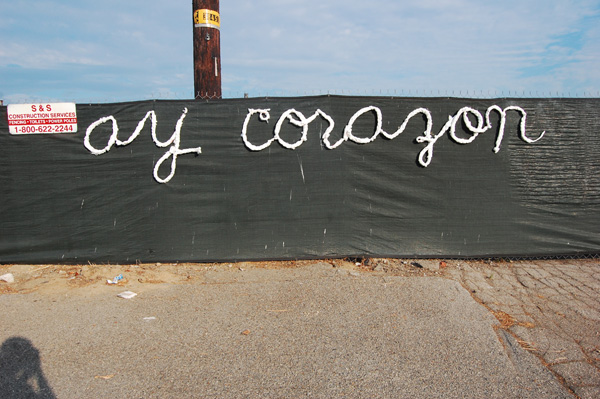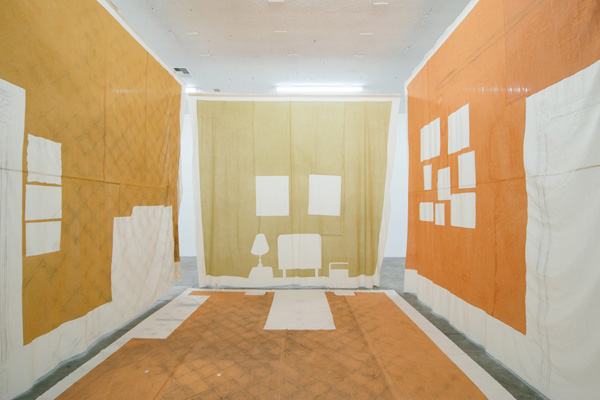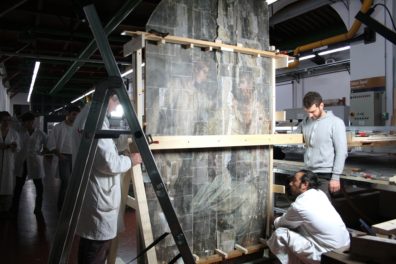Pacific Standard Time: LA/LA takes the stage for a two-day gathering at the San Diego Museum of Art and the Getty Center

Oscar Romo’s presentation at “LA/LA: Place and Practice.” Slide image: Tires and garbage repurposed into a public park. Photo courtesy of Alter Terra
Last week more than 350 people congregated in San Diego and Los Angeles for “LA/LA: Place and Practice,” a two-day convening on May 2 and 4 created in partnership with the Getty Foundation, the Getty Research Institute, the San Diego Museum of Art, and Scripps College, and organized by Ken Gonzales-Day, Bill Kelley Jr., and Pilar Tompkins Rivas. The program (details here) and the work shared by participants was complex and varied.
 Moving back and forth between formal roundtable discussions and quick six-minute presentations by artists, collectives, urbanists, scholars, curators, and activists, the energy of the two days was fueled by a sense of community between the participants and the audience. This convening introduced a wide range of socially engaged projects, but it was the opportunity to share these two days together as a community that created a rare and memorable dialogue amongst colleagues, old friends, and new collaborators.
Moving back and forth between formal roundtable discussions and quick six-minute presentations by artists, collectives, urbanists, scholars, curators, and activists, the energy of the two days was fueled by a sense of community between the participants and the audience. This convening introduced a wide range of socially engaged projects, but it was the opportunity to share these two days together as a community that created a rare and memorable dialogue amongst colleagues, old friends, and new collaborators.
Here are some highlights of the program that resonated with me.
Art and Activism
Although the first day of the convening at the San Diego Museum of Art offered many inspiring roundtable conversations and artist presentations, one of the key themes of the day was triggering change and awareness in local communities through activism-driven projects.
An example is the organization Alter Terra, whose founder Oscar Romo discussed environmental solutions for the heavily polluted wetlands located at the border region of Tijuana/San Diego. The mission of Alter Terra is to build international partnerships for environmental conservation, but one of their most compelling projects is a community-based effort in Tijuana in which people from different neighborhoods repurpose garbage into functional products, striking art projects, and structural systems that transform the urban landscape.
It was a revelation to learn from artists Patricia Valencia and Aida Salazar about the history of Regeneración, a collective from the 1990s that followed the Zapatista model for liberation and justice through art, music, collaboration, and public protests. The legacy of Regeneración has inspired present-day collectives such as School of Echoes, Mujeres de Maíz, and Las Cafeteras, who also participated in the symposium.

South El Monte Arts Posse presentation at “LA/LA: Place and Practice.” Slide image: Ay Corazón, 2012, by Carribean Fragoza, a poem-installation at a vacant lot in South El Monte, made with plastic grocery bags and copper wire, near the entrance to the 60 freeway. Courtesy of SEMAP
Others groups such as South El Monte Arts Posse (SEMAP), led by artist and writer Carribean Fragoza and historian Romeo Guzmán, and Cocina Abierta, led by Christina Sánchez Juárez and Cayetano Juárez, were good examples of how experimental collective models can expand beyond art and activism to incorporate other seemingly unrelated practices. SEMAP joins community through art projects, youth programs, urban initiatives, and archive recoveries. It’s an inclusive approach, encompassing everything from teaching history in schools to site-specific poetry in abandoned lots.
Familiar with the fad of pop-up restaurants? Cocina Abierta is taking mobile cuisine in a more decidedly political direction. Sánchez Juárez describes their practice as “a nomadic experimental test kitchen,” combining artistic and pedagogical strategies with communal cooking to raise consciousness about labor ethics.
Migrations and Borders
One of the most compelling sessions of the second day, at the Getty Center on May 4, was the opening panel that centered on migration issues. Teddy Cruz gave a talk about his research on “The Political Equator,” the global border connecting three primary points of territorial conflict: San Diego/Tijuana, Ceuta/Melilla, and Israel/Palestine. Cruz advocates understanding territorial conflict as a tool for organization, pushing us to rethink the current definitions of citizenship to move beyond ties to individual nation states.

Slide from Teddy Cruz’s presentation at “LA/LA: Place and Practice.” Image shown: “The Political Equator.” Image courtesy of Teddy Cruz
Expanding on the idea of site and citizenship as tools for knowledge, Amy Sanchez and Misael Diaz from the Cog•nate Collective presented their project Borderblaster SD/TJ (2012). The work used community engagement and radio airwaves as media, transmitting a series of conversations among vendors, artisans, and activists at the San Ysidro Port of Entry to cars waiting in line to cross the border via a vacant frequency on the FM dial in San Diego/Tijuana.
Transborder issues and migrating histories were also present in the work of L.A. artist Carmen Argote. For My Father’s Side of Home, Argote traveled to her father’s childhood home in Guadalajara and traced the furniture and ornaments of his old room, bringing those silhouettes back to this side of the border for an exhibition in Los Angeles. By trailing her family’s movement back and forth across the border, she demonstrates the malleability of the concepts of home, identity, and memory.

From artist Carmen Argote’s presentation at “LA/LA: Place and Practice.” Slide image: My Father’s Side of Home, exhibition at Human Resources, Los Angeles, November, 2014. Image courtesy of the artist
Weaving it All Together
As the grand finale to this energizing event, Las Cafeteras engaged the audience through spoken word, and their musical and activist projects, ending with a live performance of one of their songs. Being together in open dialogue for two days invigorated scholars, artists, curators, activists, and participants. Multi-faceted artist an curator Raquel Gutiérrez may have said it best, when she pointed out during her presentation: “We have no reason for coming together other than to be woven together.”
CONTINUARÁ…




This entry in particular is a perennial reference for practices, artists, and important cultural work occurring in our region. The more I reference this page the more I appreciate the author’s succinct, insightful analysis and capture.